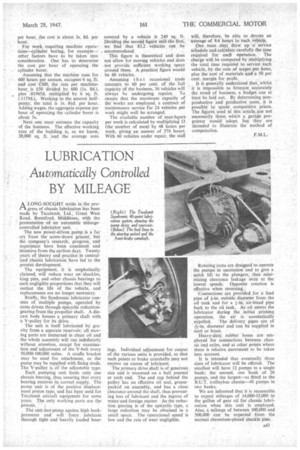PLANNED PRODUCTION
Page 54

Page 57

If you've noticed an error in this article please click here to report it so we can fix it.
in repair work
How the Incentive Method of Organization May be Applied to the Business of a Repairer to Speed up Production and IncreaseTurnover
MOST garages undertaking engine, chassis and body repairs consider that organized working and scientific methods of costing are impracticable. Many reasons are given, the main one being that the difficulties that are likely to arise cannot be forecast. Others are the wide variety of repairs to be done and the lack of experienced labour. In other words, jobbing or repair work seems to produce an antipathy to organization on a production incentive basis.
In a business where, for example, 10 or more mechanics are employed on a variety of repair jobs, there is no reason why the work should not be planned by the incentive method. My experience is that on a fixed-day work basis accurate costs and delivery promises are almost impossible to realize.
A Concrete Case
Consider the case of a private-car and commercial-vehicle repair business with a steady flow of work. Like any other business, to secure maximum efficiency the work will have to be planned. Assume that the personnel employed comprise the proprietor, foreman, typist, storekeeper and handyman, 10 mechanics and two apprentices. In this case, as the number of personnel is small, the foreman controls the detail and routine of the business. How does he tackle the job?
When a vehicle is brought in for repair, it is his function to diagnose the fault, decide on the remedy, estimate how long the work will take and prepare an economic, yet attractive, bonus time.
This information, with relevant data of the vehicle, is recorded on a special form and then typed on an almost identical form (reproduced with this article). On the back of the card are spaces for clocking on and off to determine accurately the actual hours spent on the job. The card is placed in a rack bearing a mechanic's number and is issued when required.
The foreman estimates the time required in the following manner:— m.
1, Jack-up chassis for welding.. 20
2. Dress broken web with wire brush and portable grinder — • • -4 20
3. Weld in position (three runs of weld) —
4. Fit mild-steel plate between webs _
and weld along all four sides 2 0 5. Remove all tackle and take vehicle off pit .. .. 15 3 35
6. Add 10 per cent, for fatigue, contingency and personal allowance .. 21
Total .. . .. 3 56
Say, 4 hours.
If the foreman's estimate is found to be low, intelligent co-operation and Estimated working hours per annum, at 48 hours per week, 50 weeks per year, allowing 25 per cent, for contingencies, total 1,800. The effective working area of the building is 200 ft. by 100 ft. (20,000 sq. ft.) and the overhead cost per square foot per hour is:— £2,948 Y. 240
.0I965d.
1,800 x 20,000 The average floor area covered by each vehicle is, say, 240 sq. ft., so that the cost of overheads per vehicle per hour is 240 by .01965d., which equals 4.71d., say 4„id.
Wages are computed at 3s. 3d. per hour. The full rate per hour on day work is taken as 2s. 6d., including cost-ofliving bonus. If the bonus rate is Is. 6d. per hour and the mechanic is awarded a 50 per cent, bonus, his hourly earnings will total 2s. 6d, plus 9d. (3s. 3c1.). Including wages and overheads at 40.
per hour, the cost is about 3s. 8d. per hour.
For work requiring machine operations—cylinder boring, for example— other factors have to be taken into consideration. One has to determine the cost per hour of operating the cylinder borer.
Assuming that the machine runs for 600 hours per annum, occupies 6 sq. ft. and cost £300, the rate per machinehour. is £50 divided by 600 (Is. 8d.), plus .01965d. multiplied by 6 sq. ft. (.1179d.). Working to the nearest halfpenny, the total is Is. 80. per hour. Adding wages, the aggregate expense per hour of operating the cylinder borer is about 5s.
Next one must estimate the capacity of the business. The effective working area of the building is, as we know, 20,000 sq. ft. and the average area covered by a vehicle is 240 sq. ft. Dividing the second figure int6.4Jhe first, we find that 83/ vehicles can be accommodated.
This figure is theoretical and does not allow for moving vehicles and does not provide sufficient working space around them. A practical figure would be 60 vehicles.
Assuming that occasionaltrade amounts to 60 per cent. of the full capacity of the business, 36 vehicles will always be undergoing repairs. To ensure that the maximum capacity of the works are employed, a contract of maintenance service for 24 vehicles per week might well be arranged.
The available number of man-h9urs per week:is calculated by multiplying 12 (the number, of men) by 48 hours per week, giving an answer of 576 hours. With 60 vehicles under repair, the staff will, therefore, be able to devote an average of 9.6 hours to each .vehic1P.
One must next draw up •a serVice schedule and ealculate carefully the time required for each operation. The charge will be computed by Multiplying the total time required to service each vehicle, by the Tate of wages per hour, plus the cost of materials and a 50 per cent, margin for profit.
It is generally understood that, whilst it is impossible to forecastaccurately the trend of business, a bUdget. can at least be laid out,. By determining nonproductive and productive costs, it is possible to quote competitive prices. The figures. used in this article are not necessarily those which a garage proprietor would adopt, but they are intended to illtistrate the method of computation.
F.M.L.
















































































